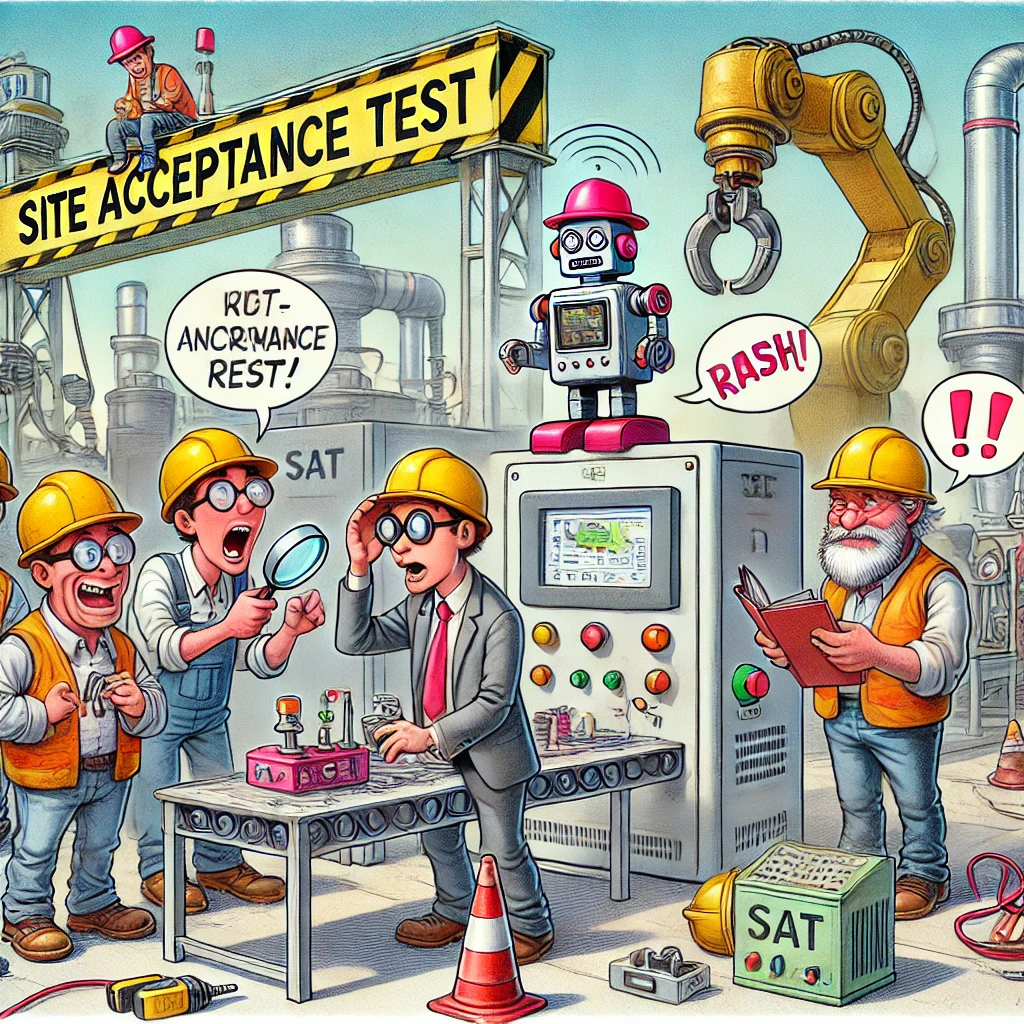SAT (Site Acceptance Test): Safety and Efficiency is a vital phase in commissioning industrial systems and machinery. Conducted at the client’s site, this process ensures that equipment operates according to predefined specifications and is ready for use. It is essential for verifying that all components function correctly in real-world environmental conditions and comply with safety standards and regulations.
Table of Contents
What is SAT?
The Site Acceptance Test involves final testing of machines or systems at the client’s installation site. The goal of SAT is to ensure that the equipment has been properly installed, configured, and is ready for operation. Typically, a Factory Acceptance Test (FAT) is conducted at the manufacturer’s facility before SAT to confirm that the equipment meets the client’s requirements.
Why is it Important?
SAT allows clients to verify that the equipment operates according to their requirements and is fully functional. This process is crucial because it helps identify and correct any issues before the system is handed over for use, thereby avoiding costly and time-consuming repairs in the future.
Differences Between SAT and FAT
The main difference between Site Acceptance Test (SAT) and Factory Acceptance Test (FAT) lies in the location and timing of the tests. FAT is conducted at the manufacturer’s facility before the equipment is delivered to the client, while SAT takes place at the installation site after delivery and installation.
Procedure
Planning
Planning for SAT includes preparing the test environment, defining test objectives, and selecting testing methods. It is also crucial to establish acceptance criteria and prepare documentation.
Preparation
Preparation involves installing and configuring the system or machinery to be tested. Preliminary functional and performance tests should also be conducted.
Execution
SAT typically includes several tests such as performance, functionality, operability, and safety tests. All results are documented and evaluated for compliance with requirements.
Documentation
Results from SAT are documented and assessed to determine if all requirements have been met. If issues are identified, corrective actions are taken, and the test is repeated until compliance is achieved.
Acceptance
If requirements are met, the system or machine is accepted by the client. Otherwise, corrections are made, and the test is conducted again.
Benefits of Conducting SAT
- Quality Verification: Ensures that requirements and specifications are met.
- Early Error Detection: SAT allows for early detection and correction of issues, helping to avoid costly repairs.
- Customer Satisfaction: Increases customer satisfaction by ensuring that the equipment meets their requirements.
Significance in Industrial Automation
SAT is an indispensable part of industrial automation as it confirms that all systems operate correctly under real operational conditions. These tests are particularly important for industrial robots and production lines, where even minor discrepancies can lead to significant production issues.
Standards and Regulations
SAT helps in meeting various standards and regulations such as the Machinery Directive 2006/42/EC and the Machinery Regulation 2023/1230. Tests also check compliance with harmonized standards and whether the manufacturer has conducted a risk assessment according to PN-EN ISO 12100:2012. Verification of the CE mark, which confirms compliance with EU requirements, is also a crucial element.
Support from Design Offices and Engineer Outsourcing
Conducting SAT often requires collaboration with a design office that oversees implementation. Sometimes, engineer outsourcing is necessary to ensure the right competencies for comprehensive acceptance tests.

Site Acceptance Test (SAT) is a crucial phase in the commissioning of industrial machines and systems, ensuring that equipment operates according to client requirements under real operational conditions. Proper planning, preparation, execution, and documentation help identify and correct issues, thereby increasing customer satisfaction and product quality.
Additional Aspects of SAT in Industry Context
- Automation of Production Processes: SAT plays a key role in verifying automated production lines and robotic workstations.
- CE Certification of Machines: The test is the final stage of certification, where the completeness and compliance of all documents and markings are checked.
- PLC Programming and SCADA: SAT includes training on control systems and checking safety functions.
- Machine Safety and Guards: Tests verify the correct installation of machine guards and test locking systems.
- Strength Calculations (FEM): Verification of technical documentation and completeness of strength calculations is a key element of SAT.
Significance in Project Management
SAT is a milestone in project management that often determines the acceptance of a production line or machine. Its proper execution is crucial for project success and achieving all set KPIs (Key Performance Indicators). The test ensures that production lines and industrial robots meet all client requirements and are ready for operation.
Importance of SAT in Certification and Compliance Processes
SAT is a critical component in certification processes, such as conformity assessment of machines and verification of the EU Declaration of Conformity. Tests check whether machines have the appropriate certificates and meet the requirements of the Machinery Directive 2006/42/EC and other regulations like the Low Voltage Directive and Electromagnetic Compatibility.
Significance in Safety and Risk Context
During SAT, a risk assessment related to the Tool Directive is also conducted to ensure that all potential hazards are properly managed. It is checked whether machines have appropriate guards and service platforms that ensure safe access to all service parts.
The test also includes verification of compliance with ATEX requirements if the equipment is intended for use in explosive atmospheres. It is important that all components have the appropriate certificates and documentation confirming their safety.

Importance of SAT in Production Optimization
SAT plays a crucial role in the automation of production processes, allowing verification of system efficiency and performance. Tests also check OEE (Overall Equipment Effectiveness) indicators and conduct SMED (Single-Minute Exchange of Dies) tests aimed at optimizing machine changeover time.
Importance in Design and Technical Documentation Context
Conducting SAT requires close collaboration with a design office that oversees implementation and checks whether all aspects of machine design have been correctly implemented. Verification of technical documentation is a key element of the test, ensuring that all components comply with technical requirements.
Support from Industrial Automation Integrators
SAT often requires the involvement of an industrial automation integrator responsible for the installation and configuration of automation systems. The test also includes training on SCADA and PLC systems, ensuring that the client’s personnel are fully prepared to manage new systems.
Importance of SAT in Compliance with Standards and Regulations
Conducting SAT is crucial for meeting the requirements of standards and regulations, such as the Low Voltage Directive and Electromagnetic Compatibility. The test checks whether all components and systems comply with the appropriate harmonized standards, which is necessary for obtaining the CE mark.
Site Acceptance Test is a crucial phase in the commissioning of industrial machines and systems, ensuring that equipment operates according to client requirements under real operational conditions. Proper planning, preparation, execution, and documentation help identify and correct issues, thereby increasing customer satisfaction and product quality. Conducting tests with due diligence and according to guidelines is essential for ensuring high quality and safety of machines and systems in an industrial environment.
FAQ: SAT
Site Acceptance Test (SAT) is a process where a machine or system is tested and accepted at the client’s installation site. The purpose of SAT is to ensure that the equipment has been properly installed, configured, and is ready for use.
Factory Acceptance Test (FAT) is conducted at the manufacturer’s facility before delivering the equipment to the client, whereas SAT takes place at the installation site after delivery and installation. This test verifies the equipment’s operation in real operational conditions.
It allows the client to verify that the equipment operates according to their requirements and is fully functional. It helps identify and correct any issues before the system is handed over for use, avoiding costly repairs.
The procedure includes several stages: planning, preparation, test execution, result documentation, and acceptance. Each stage aims to ensure that the equipment operates according to the client’s requirements.
The process usually involves engineers from both sides, an industrial automation integrator, and sometimes outsourced engineers. It is crucial to involve specialists who can verify equipment operation and ensure compliance with requirements.
It ensures quality verification, early error detection, and increases customer satisfaction. It also helps meet the requirements of standards and regulations.
Requirements of standards and regulations such as Machinery Directive 2006/42/EC, Low Voltage Directive, Electromagnetic Compatibility and ATEX are checked if required.
Complete technical documentation, user manuals, and all certificates and declarations of conformity are necessary. It is also important that all documents are up to date.
It includes performance, functionality, operability, and safety tests. Tests related to SCADA systems, PLC programming, and compliance with machine safety requirements are also conducted.
The most common issues are non-compliance with technical requirements, installation and configuration problems, and documentation gaps. Resolving these issues requires thorough verification, corrections, and collaboration with the appropriate specialists to ensure all requirements are met.
